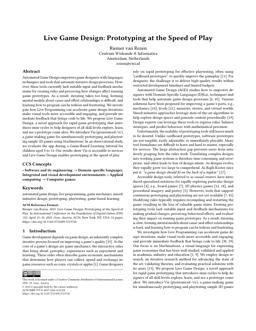2025-04-23
Live game design: Prototyping at the speed of play
Publication
Publication
Proceedings of the 20th International Conference on the Foundations of Digital Games (FDG’25) p. 1- 12
Automated Game Design empowers game designers with languages, techniques and tools that automate iterative design processes. How- ever, these tools currently lack suitable input and feedback mecha- nisms for creating rules and perceiving how changes affect running game prototypes. As a result, iterating takes too long, forming mental models about cause-and-effect relationships is difficult, and learning how to program can be tedious and frustrating. We investi- gate how Live Programming can accelerate game design iterations, make visual tools more accessible and engaging, and provide im- mediate feedback that brings code to life. We propose Live Game Design, a novel approach for rapid game prototyping that intro- duces mini-cycles to help designers of all skill levels explore, learn, and see a prototype come alive. We introduce Vie (pronounced /vi/), a game-making game for simultaneously prototyping and playtest- ing simple 2D games using Machinations. In an observational study, we evaluate the app during a Game-Based Learning tutorial for children aged 8 to 14. Our results show Vie is accessible to novices and Live Game Design enables prototyping at the speed of play.
| Additional Metadata | |
|---|---|
| , , , , , , , | |
| doi.org/10.1145/3723498.3723726 | |
| Proceedings of the 20th International Conference on the Foundations of Digital Games (FDG’25) | |
| 20th International Conference on the Foundations of Digital Games (FDG’25) | |
| Organisation | Software Analysis and Transformation |
|
van Rozen, R. (2025). Live game design: Prototyping at the speed of play. In Proceedings of the 20th International Conference on the Foundation of Digital Games (pp. 1–12). doi:10.1145/3723498.3723726 |
|

